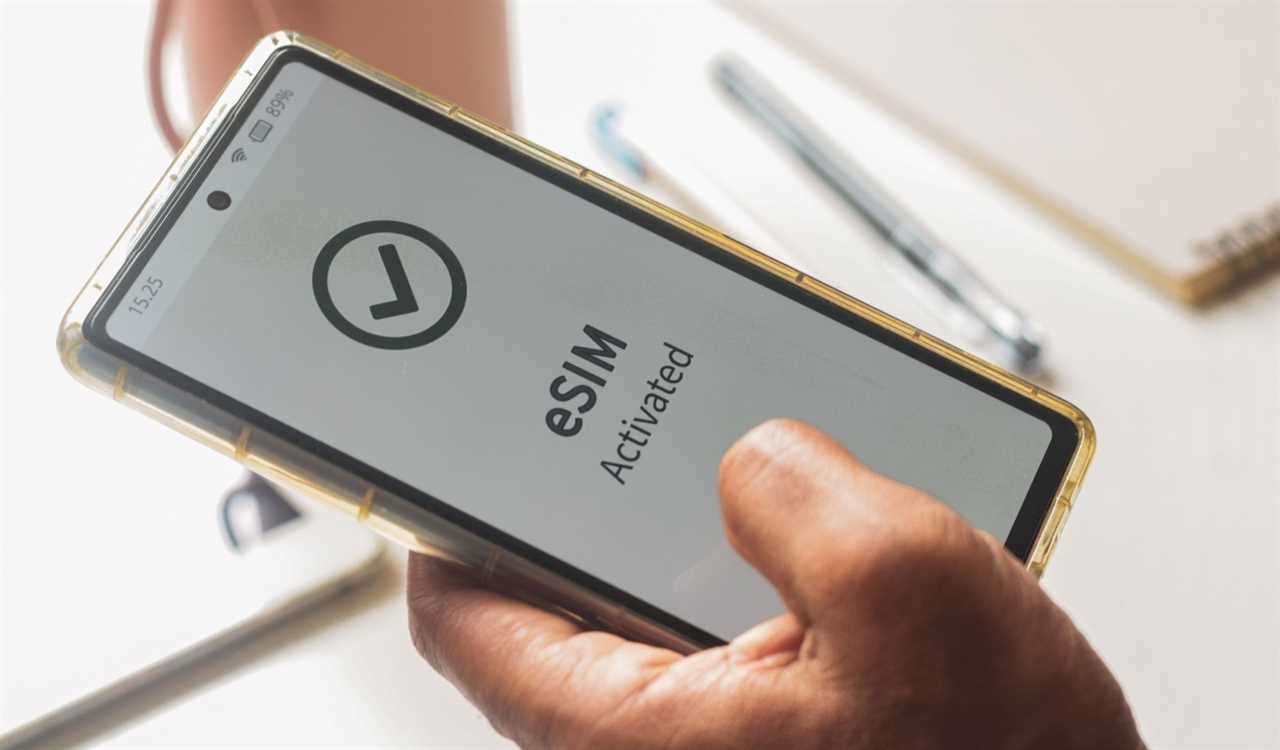
Having reliable mobile data when you travel is a must these days. It’s helpful not only for finding things to do or the right bus route, but communicating in an emergency and locating your accommodation if you get lost.
While I think a lot of travelers spend too much time on their phone, the fact of the matter is that modern travel requires mobile data.
In the past, that meant paying excessive roaming fees to your phone provider or finding and buying physical SIM cards at the airport. I used to spend fortune on mobile data whenever I went on a long trip. It sucked.
Fortunately, today, there’s a cheaper and more convenient solution: eSIMs.
I started using eSIMs recently and they’ve been a game changer.
So, in this post, I’ll break down what exactly an eSIM is and share my favorite eSIM companies so that you can stay connected on your next trip — without breaking the bank.
What is an eSIM?
A SIM card is a small memory card that you insert into your smartphone in order to make calls and use mobile data. It has unique identifiers that ensure that when people call you, the call comes to your device (and not someone else’s). You generally get one from your phone provider when you sign your contract.
An eSIM is a digital version of this.
Instead of a physical memory card, you instead install software on your smartphone that replicates the same functions as the physical card. Most smartphones only have a single port for a physical SIM card, so the benefit of using eSIMs is that you can have multiple eSIMs on a single device.
For example, if you’re from Germany and are visiting the United States, you’ll need to physically remove your German SIM card on arrival and install a physical US SIM card if you want to avoid paying excessive roaming fees. But once you swap SIM cards, you won’t be able to receive calls or texts to your German phone number unless you physically remove the US SIM card and put the German SIM card back into your phone.
This is a tedious process if you need to access multiple numbers during your trip. Hence the convenience of eSIMs. They make it super easy to visit multiple countries each year without having to juggle SIM cards. And since they let you get set up before you arrive, you can get mobile data the minute you touch down.
Why use an eSIM?
Convenience – Not only can you set up your eSIM from the comfort of home, but you can do it before you leave so it’s ready when you arrive. (If you forget to do so, you can purchase an eSIM and get connected in seconds.) Plus, you can also extend your plans or upgrade them on the fly, which is much easier (and faster) than having to extend the plan for a physical SIM card.
Price – eSIMs are super cheap now, with plans starting at just $4–5 USD. That’s a fraction of what you’ll pay for a roaming plan!
Extra Perks – Some companies (such as Jetpac) offer extra perks beyond just the eSIM data package. These can include things like lounge access for delayed flights and free VPN trials.
Customer Service – If you buy a SIM card on arrival at the airport, you can’t really go back to that airport kiosk if you have a problem since you’ll likely have traveled onward. With an eSIM, you’ll have 24/7 access to online support for questions and troubleshooting.
Multiple Usage – While some eSIMs will expire, it’s possible to get eSIMs that you can reuse again and again, saving you time and energy.
The Best eSIMs for Travelers

Jetpac
Jetpac is a travel eSIM company founded in Singapore. They offer affordable mobile data coverage to over 150 destinations around the world. I like that they offer regional bundles so that you can visit more than one country with the same eSIM and still have reliable coverage.
What I especially love, though, is that it’s just a one-time installation. Many other eSIMs require a new installation for each new eSIM that you buy. That’s not the case with Jetpac, making this a great choice for travelers who want a hassle-free eSIM (especially travelers who are less tech savvy).
Jetpac doesn’t just offer eSIMs though. They actually have some pretty solid travel perks, which, in my mind, is what makes them the best eSIM for travelers. This includes free lounge access at the airport if your flight is delayed, and a free trail of ExpressVPN (which can keep your mobile data safe and secure while abroad).
Jetpac at a glance:
- Affordable prices starting at just $1 USD
- Free lounge access for flight delays
- Free ExpressVPN trial
- Exclusive discounts on airport lounges and fast tracks, offering over 40% off
- Data packs are valid one year from purchase
- Simple, one-time installation
- Hot spot capabilities
Click here to learn more about Jetpac eSIMs!
Holafly
Holafly has a ton of plans, many with unlimited data, all connected to reliable networks so you’re covered no matter where you travel. They offer plans to 160 destinations, and the ability to access unlimited data is a big plus in my book. As such, they’re great for heavy data users. Plus, you can hot spot your friends up to 1 GB of data per day.
Holafly at a glance:
- Plans from 5-90 days
- Unlimited data starting at $19 USD
- Easy installation process
- 24/7 customer support
- 1 GB of data sharing (hot spotting) per day
Airalo
Airalo is one of the biggest eSIM providers in the world, with plans covering over 200 countries/regions. They make it super easy to setup your eSIM, with a sleek website and reliable customer service. In addition to country-specific eSIMs, they also have regional data packs as well as global packs that cover over 135 countries (perfect for long-term nomads).
Airalo at a glance:
- Country, region, and global data packs
- 200+ countries/regions covered
- Plans starting at just $4.50 USD
- Easy to set up
- 24/7 customer support
Frequently Asked Questions (FAQs) about eSIMs:
Do eSIMs support phone calls and SMS messages or just data?
Some eSIMs do, though most eSIMs currently offer data only. If you need to be able to make local or international calls on a data-only eSIM, there are a lot of ways to do this (like WiFi calling, Google Voice, or Skype).
How do I activate an eSIM?
You can activate an eSIM by scanning a QR code provided by your carrier or by entering activation details in your phone’s settings. All eSIM providers will have detailed instructions on how to activate their eSIM, and all good carriers should have 24/7 customer support to help you if needed.
Which devices support eSIM?
Most newer (post-2018) smartphones support eSIMs. Most providers have a list of phone models that support eSIMs, so make sure to check before purchasing one (especially if you have an older phone).
Can I use both an eSIM and a physical SIM on my device?
Many (though not all) devices offer dual-SIM functionality, allowing you to use both an eSIM and a physical SIM at the same time. Make sure to look into international roaming charges with your home provider before you keep your physical SIM active abroad. If you want to ensure that it doesn’t automatically connect while abroad (usually incurring high roaming charges), make sure to turn off roaming for your physical SIM.
Can I switch between eSIM profiles?
Yes, you can store multiple eSIM profiles on your device and switch between them. Some newer phone models allow two eSIMs to be active at once, while others only allow one to be active at a time.
How secure is an eSIM?
eSIMs are considered more secure than physical SIM cards because they are embedded in the device and harder to tamper with.
Can I transfer an eSIM to a new device?
Some carriers allow you to transfer an eSIM to a new device, but you may need to request a new activation code from your carrier. Some carriers also only let you transfer eSIMs once, so make sure to check before doing so if you need to.
***
From booking activities to using Google Maps to calling an Uber, having mobile data makes travel easier (and safer). Fortunately, it’s never been easier to access mobile data. eSIMs are affordable, easy to use, and can even have awesome extra perks (like Jetpac’s Jetpass).
I use an eSIM whenever I travel and I encourage you to do the same. They are the best way to stay connected and make the most of your travels — no matter where you are going!
Book Your Trip: Logistical Tips and Tricks
Book Your Flight
Find a cheap flight by using Skyscanner. It’s my favorite search engine because it searches websites and airlines around the globe so you always know no stone is being left unturned.
Book Your Accommodation
You can book your hostel with Hostelworld. If you want to stay somewhere other than a hostel, use Booking.com as it consistently returns the cheapest rates for guesthouses and hotels.
Don’t Forget Travel Insurance
Travel insurance will protect you against illness, injury, theft, and cancellations. It’s comprehensive protection in case anything goes wrong. I never go on a trip without it as I’ve had to use it many times in the past. My favorite companies that offer the best service and value are:
- SafetyWing (best for everyone)
- InsureMyTrip (for those 70 and over)
- Medjet (for additional evacuation coverage)
Want to Travel for Free?
Travel credit cards allow you to earn points that can be redeemed for free flights and accommodation — all without any extra spending. Check out my guide to picking the right card and my current favorites to get started and see the latest best deals.
Need Help Finding Activities for Your Trip?
Get Your Guide is a huge online marketplace where you can find cool walking tours, fun excursions, skip-the-line tickets, private guides, and more.
Ready to Book Your Trip?
Check out my resource page for the best companies to use when you travel. I list all the ones I use when I travel. They are the best in class and you can’t go wrong using them on your trip.
The post The Best eSIMs for Travelers appeared first on Nomadic Matt's Travel Site.
-------------------------
By: Matthew Kepnes
Title: The Best eSIMs for Travelers
Sourced From: www.nomadicmatt.com/travel-blogs/best-esims-for-travelers/
Published Date: Fri, 01 Nov 2024 13:30:09 +0000
Read More
 General Health and WellnessFitness and ExerciseSupplements and VitaminsPandemic NewsVideosPrivacy PolicyTerms And Conditions
General Health and WellnessFitness and ExerciseSupplements and VitaminsPandemic NewsVideosPrivacy PolicyTerms And Conditions
